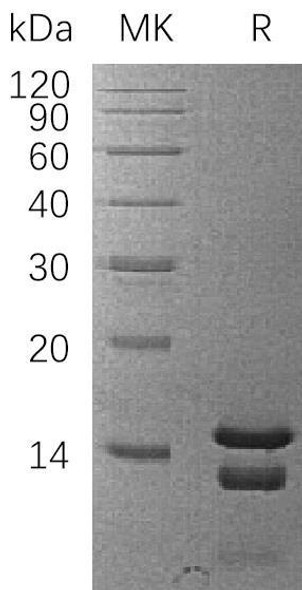Description
| Product Name: | Human PEA15 Recombinant Protein |
| Product Code: | RPPB4220 |
| Size: | 10µg |
| Species: | Human |
| Target: | PEA15 |
| Synonyms: | Astrocytic phosphoprotein PEA-15, 15 kDa phosphoprotein enriched in astrocytes, Phosphoprotein enriched in diabetes, PED, PEA15, MAT1, HMAT1, MAT1H, PEA-15, HUMMAT1H. |
| Source: | Escherichia Coli |
| Physical Appearance: | Sterile Filtered colorless solution. |
| Formulation: | The PEA15 protein solution contains 20mM Tris-HCl buffer (pH 7.5), 1mM DTT and 10% Glycerol. |
| Stability: | Store at 4°C if entire vial will be used within 2-4 weeks.Store, frozen at -20°C for longer periods of time. For long term storage it is recommended to add a carrier protein (0.1% HSA or BSA).Please prevent freeze-thaw cycles. |
| Purity: | Greater than 90.0% as determined by SDS-PAGE. |
| Amino Acid Sequence: | MAEYGTLLQD LTNNITLEDL LKSACKED IPSEKSEEIT TGSAWFSFLE HNKLDKDNL SYIEHIFEIS RRPDLLTMVV DYRTRVLKIS EDELDTKLT RIPSAKKYKD IIRQPSEEEI IKLAPPPKKA |
PEA15 (Phospho-enriched protein in astrocytes 15kDa) is a death effector domain (DED)-containing protein mainly expressed in the central nervous system, principally in astrocytes. PEA15 is implicated in the regulation of various cellular processes including apoptosis, proliferation, glucose transport, adhesion and migration. Increased PEA15 levels have an affect tumorigenesis and cancer progression, therefore it is overexpressed in breast cancers and gliomas as well as in type 2 diabetes. PEA15 blocks Ras-mediated inhibition of integrin activation and modulates the ERK MAP kinase cascade. PEA15 also inhibits RPS6KA3 activities by holding it in the cytoplasm. In addition, PEA15 inhibits both TNFRSF6 and TNFRSF1A mediated CASP8 activity and apoptosis. PEA15 is ubiquitously expressed. PEA15 is most abundant in tissues such as the heart, brain, muscle and adipose tissue which use glucose as an energy source. Lower PEA15 expression is in glucose-producing tissues. Higher levels of PEA15 expression are found in tissues from individuals with type 2 diabetes than in controls.PEA15 expression is a significant prognostic marker in ovarian cancer.
PEA15 Human Recombinant produced in E.Coli is a single, non-glycosylated, polypeptide chain containing 130 amino acids (1-130 a.a.) and having a molecular mass of 15kDa.The PEA15 is purified by proprietary chromatographic techniques.
| UniProt Protein Function: | PEA-15: an ubiquitously expressed anti-apoptotic protein. Inhibits both Fas- and Tnfrsf1a/Tnfr1-mediated caspase-8 activity and apoptosis. Interacts with CASP8/FLICE and FADD. Regulates glucose transport by controlling both the content of GLUT1 glucose transporters on the plasma membrane and the insulin-dependent trafficking of GLUT4 from the cell interior to the surface. Most abundant in tissues such as heart, brain, muscle and adipose tissue which utilize glucose as an energy source. Lower expression in glucose-producing tissues. Higher levels of expression are found in tissues from individuals with type 2 diabetes than in controls. |
| UniProt Protein Details: | Protein type:Motility/polarity/chemotaxis; Apoptosis Chromosomal Location of Human Ortholog: 1q21.1 Cellular Component: cytosol; microtubule associated complex Molecular Function:protein binding Biological Process: activation of MAPK activity; activation of MAPKK activity; apoptosis; axon guidance; carbohydrate transport; DNA damage checkpoint; epidermal growth factor receptor signaling pathway; fibroblast growth factor receptor signaling pathway; innate immune response; insulin receptor signaling pathway; MAPKKK cascade; negative regulation of glucose import; nerve growth factor receptor signaling pathway; Ras protein signal transduction; response to morphine; small GTPase mediated signal transduction; transport; vascular endothelial growth factor receptor signaling pathway |
| NCBI Summary: | This gene encodes a death effector domain-containing protein that functions as a negative regulator of apoptosis. The encoded protein is an endogenous substrate for protein kinase C. This protein is also overexpressed in type 2 diabetes mellitus, where it may contribute to insulin resistance in glucose uptake. Alternative splicing results in multiple transcript variants. [provided by RefSeq, Jul 2014] |
| UniProt Code: | Q15121 |
| NCBI GenInfo Identifier: | 32470612 |
| NCBI Gene ID: | 8682 |
| NCBI Accession: | Q15121.2 |
| UniProt Secondary Accession: | Q15121,O00511, B1AKZ3, |
| UniProt Related Accession: | Q15121 |
| Molecular Weight: | 17,307 Da |
| NCBI Full Name: | Astrocytic phosphoprotein PEA-15 |
| NCBI Synonym Full Names: | phosphoprotein enriched in astrocytes 15 |
| NCBI Official Symbol: | PEA15�� |
| NCBI Official Synonym Symbols: | PED; MAT1; HMAT1; MAT1H; PEA-15; HUMMAT1H�� |
| NCBI Protein Information: | astrocytic phosphoprotein PEA-15 |
| UniProt Protein Name: | Astrocytic phosphoprotein PEA-15 |
| UniProt Synonym Protein Names: | 15 kDa phosphoprotein enriched in astrocytes; Phosphoprotein enriched in diabetes; PED |
| Protein Family: | Astrocytic phosphoprotein |
| UniProt Gene Name: | PEA15�� |
| UniProt Entry Name: | PEA15_HUMAN |






